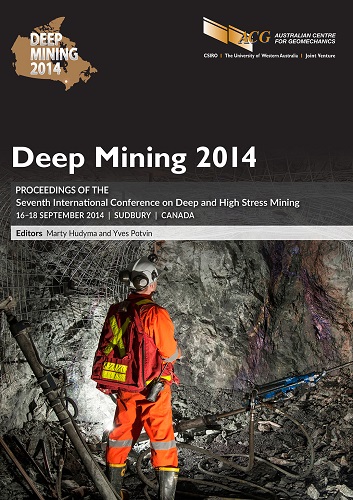Use of 3DEC to study spalling and deformation associated with tunnelling at depth

|
Authors: Garza-Cruz, TV; Pierce, M; Kaiser, PK |
DOI https://doi.org/10.36487/ACG_rep/1410_28_Garza-Cruz
Cite As:
Garza-Cruz, TV, Pierce, M & Kaiser, PK 2014, 'Use of 3DEC to study spalling and deformation associated with tunnelling at depth', in M Hudyma & Y Potvin (eds), Deep Mining 2014: Proceedings of the Seventh International Conference on Deep and High Stress Mining, Australian Centre for Geomechanics, Perth, pp. 421-434, https://doi.org/10.36487/ACG_rep/1410_28_Garza-Cruz
Abstract:
For mining at depth or deep caving operations, it is increasingly important to better understand the failure process near underground excavations and, for support design, it is necessary to better anticipate the related deformation characteristics of brittle failing rock. This paper describes how 3DEC was used to model the rock mass as an assembly of tetrahedral (tet) blocks bonded at their contacts, and to investigate spalling and unidirectional bulking of massive to moderately jointed rock masses by introducing tensile strength heterogeneity at the block contacts. The 3DEC approach differs from particle-based methods in its ability to represent a zero-initial porosity condition, as well as interlocked irregular block-shapes that provide resistance to block rotation (moments) after contact breakage. These processes tend to dominate the rock mass behaviour in low confinement zones near excavations and thus are relevant for both stability assessment and support design. The results of simulations employing this approach are summarised to assist in understanding the growth of fracture patterns and related stress redistribution, as well as deformation around a highly stressed tunnel. Mining-induced stress changes are approximated to simulate the effects of over-mining with an undercut, as typically used in a cave mine. The model response is found to be consistent with current theories concerning the spalling and bulking of massive rock at depth and with observations made in analogous civil and mining tunnels. However, the results also suggest that data from continuum models with plasticity models may be misleading in terms of extent and deformation in the non-elastic zone. This paper supports the view that excavation stability in brittle rock types is dominated by tensile or extensional failure processes near the excavation and that bulking enhanced by geometric block-shape factors needs to be considered for support design.
References:
Diederichs, MS 2007, ‘The 2003 Canadian Geotechnical Colloquium: Mechanistic interpretation and practical application of damage and spalling prediction criteria for deep tunnelling’, Canadian Geotechnical Journal, vol. 44, pp. 1082-1116.
Diederichs, MS, Kaiser, PK & Eberhardt, E 2004, ‘Damage initiation and propagation in hard rock during tunnelling and the influence of near-face stress rotation’, International Journal of Rock Mechanics and Mining Sciences, vol. 41, no. 5, pp. 785-812.
Garza-Cruz, TV & Pierce, M 2014, ‘A 3DEC Model for Heavily Veined Massive Rock Masses’, Proceedings of the 48th US Rock Mechanics/Geomechanics Symposium, American Rock Mechanics Associated, Alexandria.
Itasca Consulting Group, Inc. 2012, KUBRIX-Geo, Itasca Consulting Group, Inc., Minneapolis,
/kubrix-geo
Itasca Consulting Group, Inc. 2013, 3DEC – Three-Dimensional Distinct Element Code, version 5, Itasca Consulting Group, Inc. Minneapolis, .
Itasca Consulting Group, Inc. 2014, PFC3D – Particle Flow Code in Three Dimensions, version 5, Itasca Consulting Group, Inc., Minneapolis,
Kaiser, PK 2010, ‘How highly stressed brittle rock failure impacts tunnel design’, Proceedings of Eurock 2010, Taylor & Francis Group, London.
Kaiser, PK, Diederichs, MS, Martin, CD, Sharp, J & Steiner, W 2000, ‘Underground works in hard rock tunneling and mining’, Proceedings of GeoEng2000, Technomic Publishing Co., Lancaster, pp. 841-926.
Kaiser, PK, Kim, B-H, Bewick, R & Valley, B 2011, ‘Rock mass strength at depth and implications for pillar design’, Mining Technology, vol. 120, no. 3, pp. 170-179.
© Copyright 2025, Australian Centre for Geomechanics (ACG), The University of Western Australia. All rights reserved.
View copyright/legal information
Please direct any queries or error reports to repository-acg@uwa.edu.au
View copyright/legal information
Please direct any queries or error reports to repository-acg@uwa.edu.au